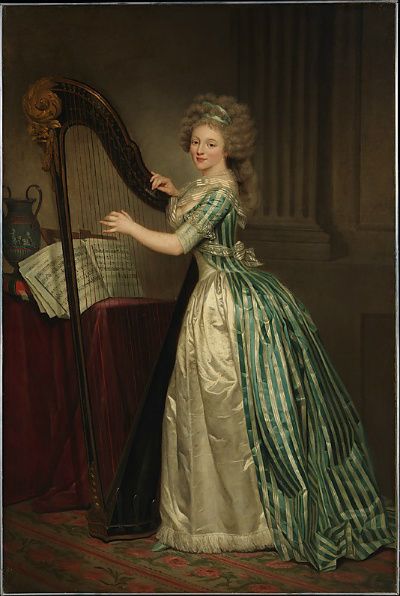Self Portrait With A Harp (Part 3)
3:03 PM
Self Portrait with a Harp, by Rose Adélaïde Ducreux, c. 1791. In the collection of The Metropolitan Museum of Art.
Ducreux’s portrait is in the neoclassical style, an important aesthetic to the Revolution. As opposed to the opulent rococo aesthetic, which had previously dominated the fine arts, neoclassicism valued simplicity and sought to emulate the plain elegance of the art of Ancient Greek and Roman societies. Neoclassicism was important to the ideals of the French Revolution in two respects. Firstly, its simplicity rejected the over-the-top luxury of the rococo aesthetic. It was a style everyone could embrace, not just those rich enough to afford it. It removed the luxury and decoration and left something plain, elegant, and basic. Secondly, it represented both classical and contemporary political equality. The inspiration for neoclassicism was taken from the ruins of Ancient Greece, famously the first democratic society. It was also an aesthetic that started in England, a constitutional monarchy where the people held power over the monarch. Neoclassicism represented an end to consumption by the few at the cost of the many, and the end to an absolute monarchy system, where the people held no power.
Ducreux’s painting features a plain background with an applied column forming the only wall decoration, and on the table next to her sits a Greek-esque vase, all signifiers of neoclassicism. Gone is the circular composition, the unnecessary frills, and rosey color palette of the rococo. Instead, Ducreux’s painting has a strong linear composition, and a mossy, more natural color palette. Neoclassicism was seen as a return to the natural, a theme reflected in the soft yellows, grays, and greens of Ducreux’s painting. She embodies a world not of colorful superfluity, but of sober simplicity. However, there is no harshness in this soberness. The stripes of Ducreux’s dress seem to mirror the column, elongating it into a soft, feminine curve. This, combined with the soft curves of the harp and the vase, detract from the harsh, straight, masculine lines and give the painting a softer, more feminine feel.
Traditional ideas of femininity are also reinforced in the use of the harp as a prop. Although the harp was a popular prop in eighteenth-century portraiture, Ducreux truly was a talented musician as well as painter. Musical talent was an important part of female accomplishment. In 1722 John Essex wrote that music “is certainly a very great Accomplishment to the LADIES; it refines the Taste, polishes the Mind; and is an Entertainment, without other Views, that preserves them from the Rust of Idleness, that most pernicious Enemy to Virtue.” The harp was considered a ‘womans instrument’, as it allowed not only the display of musical virtuosity but display of the female body. The light dancing of fingers across the strings showed off a woman’s hands and the nimbleness of her fingers, and the pedal harp allowed a woman to show off her delicate feet and ankles. Furthermore, the softer sounds produced by the instrument are in line with feminine ideals. It could also be argued that the harp was considered easier to play, as key signatures can be easily set and a consideration of sharps and flats are unnecessary, therefore it was an instrument well suited to the simplicity of the female mind.



1 comments